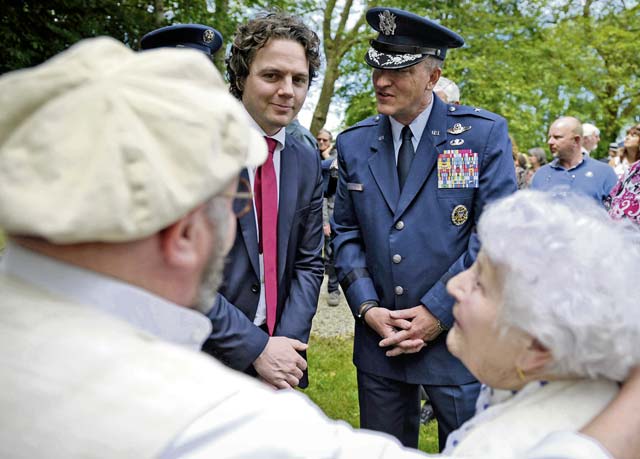
U.S. Air Force Brig. Gen. Patrick X. Mordente, 86th Airlift Wing commander, speaks with Odette Lonckheere and her son Patrick, Coigny residents, June 7 at Franquetot Castle. Odette shared her story of how she chose to join the French army alongside her husband during World War II.
COIGNY, France — Brig. Gen. Patrick X. Mordente, 86th Airlift Wing commander, and Denis Lebarbier, mayor of Coigny, France, stood together June 7 to unveil a memorial plaque dedicated to the courage and fortitude of the veterans of the 358th Fighter Group who participated in D-Day operations 70 years ago.
In his remarks to the gathered veterans and visitors, Mordente said the memorial was placed here to remind successive generations of the enormous cost of freedom.
“We build these memorials so that our children and grandchildren will never forget the stories of those who fought here,” Mordente said. “So that as the passage of time thins the ranks, it will never dim the glory of the deeds the Allies accomplished here in Normandy.”
Translated, the plaque reads, “From July 3 to Aug. 14, 1944, Franquetot Castle housed the 358th Fighter Group, which operated Advanced Land Ground A-14. Let’s remember the pilots and ground personnel who died for the liberation of France.”
Flying P-47 Thunderbolt aircraft, the 358th Fighter Group’s mission leading up to the invasion of Normandy was to attack enemy marshaling yards, airfields and communication nodes, as well as escort bombers to drop zones. On D-Day, the “Orange Tails,” so called for their distinctive orange tail markings, flew troop carrier escort missions over Normandy.
Once the Allies secured their foothold in France, the 358th took on the role of ground support, including attacking enemy tanks, vehicles, gun emplacements and anti-aircraft artillery, as well as fly interdiction, escort and close-air support duties. During World War II, the castle was used as the headquarters for the German and later U.S. armies.
“It’s important to remember that the Soldiers, Sailors and Airmen who participated in Operation Overlord came here to liberate, not conquer,” Mordente said. “The strength of the Allies’ conviction to do what was necessary was vital for peace and security in the world.”
In keeping with the theme for U.S. participation in commemorating the 70th anniversary of D-Day, “Honoring the History, Securing the Future,” the general confirmed that Americans continue to honor the history of D-Day and today share strong bonds with European Allies and partners.
“Indeed we remain indebted to the veterans whose service demonstrated the selfless actions of the ‘Greatest Generation,’” the general said. “We are grateful that out of the rubble of war, free nations conceived of and built a better future that we all enjoy today.”
After the ceremony, the townspeople gathered to take photos with the general and 86th AW Command Chief Master Sgt. Frank Batten III, along with U.S. Air Force members from the 703rd Munitions Squadron, Volkel Air Base, the Netherlands, and the 37th Airlift Squadron and 435th Contingency Readiness Group from Ramstein. After C-130Js from Ramstein flew overhead, audience members made their way to the castle for a tour and guest lecture describing the history and the important role it played during the war.







